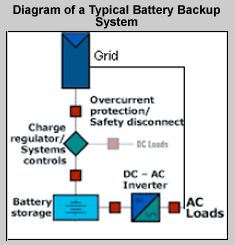Battery Backup Systems
Home > THE BASICS > Energy Options > Battery Backup Systems
Two common situations in rural and remote areas leave ICT-based businesses and facilities with intermittent or poor quality power that is insufficient to meet their needs. One situation arises when communities without grid access operate their own fossil-fuel generators, which are often connected to end users through a localized mini-grid. Because fuel is expensive, these generators may be run for 4-6 hours a day only, typically at night when there is a need for electric lighting. While operational, the generators often produce more energy than the loads consume. The unused energy is simply wasted. Another familiar situation in rural, remote and even some urban areas is one in which grid electricity is available, but there are frequent power outages. Grid outages are particularly common in communities that lie at the end of low voltage rural lines. This predicament is often accompanied by unpredictable power surges, voltage sags and other phenomena that can easily damage ICTs. In such situations, the establishment of an ICT facility that needs consistent, high-quality power may be enabled by installing a battery backup system that stores energy when the electricity supply is available. The battery backup system will convert the available variable-quality power to high quality AC power on a continuous basis and recharge the batteries while generated power is available. This solution was implemented in three USAID-funded community internet centers (CICs) run by local entrepreneurs in Rwanda in 2004. (See the Rwanda Case Study for more details) Battery backup systems require charging by an external source of power such as a grid connection, PV system or generator. The components of a battery backup system typically include batteries, a charge controller, an inverter (to power AC loads), and BOS. The diagram below shows a simplified battery backup system.
Winrock recommends the use of low maintenance, deep-cycle batteries for frequently used battery backup systems. Deep-cycle batteries are designed to withstand repeated and deep discharging of up to 80% of capacity, and will therefore provide more power over their lifetimes than standard batteries. In general, battery replacement frequency depends on how deeply the batteries have been depleted and how quickly the current is drawn from the batteries during the depletion. With less deep discharge cycles, deep-cycle batteries can last for five to seven years. There are a number of ways to acquire small-scale battery backup systems for ICT applications. Electrical contractors can custom-design a battery backup system using locally available or imported components. There are also fully integrated and automated power packages, which are designed to support a given load for a desired period of time. Commercial standby power systems are available in many models ranging from a few Watt-hours to hundreds of Watt-hours of battery capacity. They usually incorporate maintenance free, deep-cycle batteries and a modular design for flexibility and expansion. One way to reduce power system costs when using a battery bank is to run the ICT equipment directly on DC, thus eliminating the need for an inverter. In order to take advantage of this approach, the USAID-funded Alliance for Mindanao Off-grid Renewable Energy (AMORE) program, implemented by Winrock International, contracted a local computer firm called Hamtel Systems to design and assemble low-power, DC-only computing equipment for a small computing center donated to a rural farming cooperative. This computer network is described in more details in the case study section. An uninterruptible power supply (UPS) that can be coupled with additional batteries to extend runtime is potentially suitable as a backup power option for extended periods of time. These units must have a connector for attaching external batteries. One additional consideration is whether to supplement grid power for charging the batteries with electricity from a genset, PV array or other renewable energy technology. Back-up power generation can be expensive, which is why many program managers consider it only when grid electricity is not available for enough time each day to maintain the battery bank in a charged state. If a back-up power generator is required, generators often have distinct advantages in urban areas whereas renewable energy systems become more competitive when the load is in remote rural areas, distant from regular power utility services. Battery backup systems are reliable, quiet and easy to operate. If flooded batteries are used, distilled water must be added to the batteries periodically. Sealed batteries can run for extended periods (months) without user intervention. Improper battery disposal is the main environmental hazard associated with battery backup systems. As a rule of thumb, if the used batteries do not hold a value after their lifetime is over, it is likely that they will be improperly discarded and will pollute the environment. In regions such as the Amazon Forest, batteries that are not recycled often end up at the bottom of a river. Battery recycling tends to be more widespread when there are incentives offered by manufacturers or governments. Prices for batteries, inverters, racks and other components vary by country. Good-quality inverters often cost $1,000 per kW or more. UPS maintenance costs include the replacement of batteries and other components over the years of operation. Battery replacement can represent up to 60-70% of these costs. Deep cycle batteries are not readily available in all countries and they can be prohibitively expensive, particularly when imported. It is possible to use automotive or “shallow cycle” batteries, which tend to be cheaper and more widely available in rural areas. In order to maintain a reasonable battery lifespan when automotive batteries are used, the maximum depth of discharge should be no more than 20%. One key to successfully using shallow-cycle batteries for backup power systems is to make sure there is a low voltage disconnect that is set at a voltage, called the LVD setpoint, that is low enough to disconnect the batteries before they are deeply discharged. Energy efficiency measures, user training and capacity building are fundamental to keeping battery backup systems as inexpensive as possible.
|
